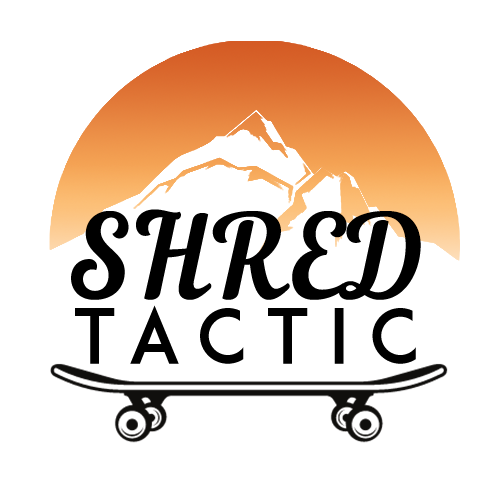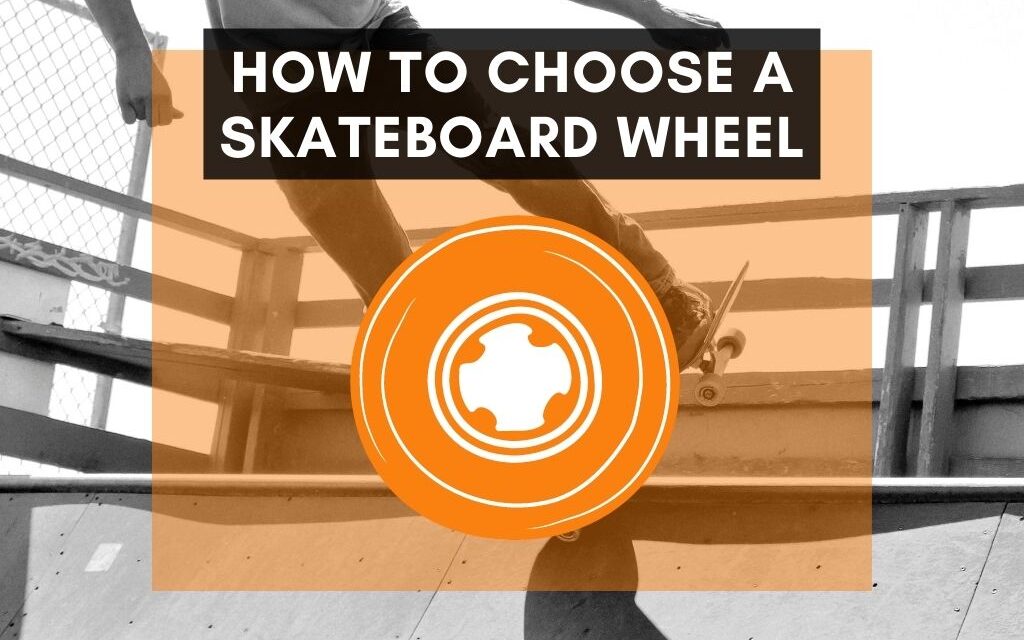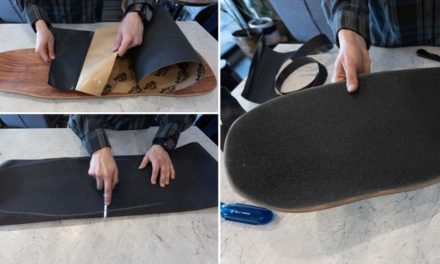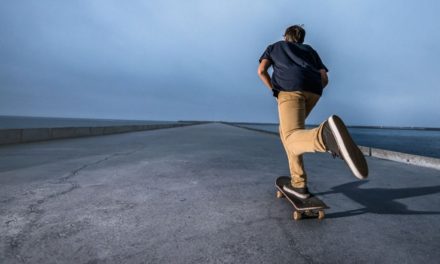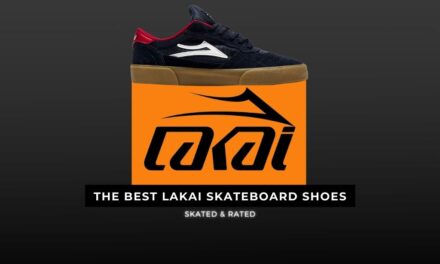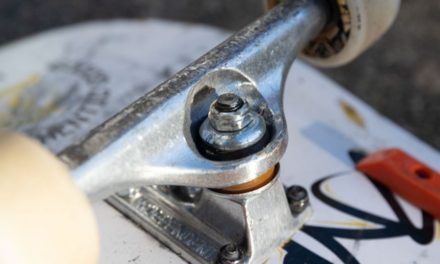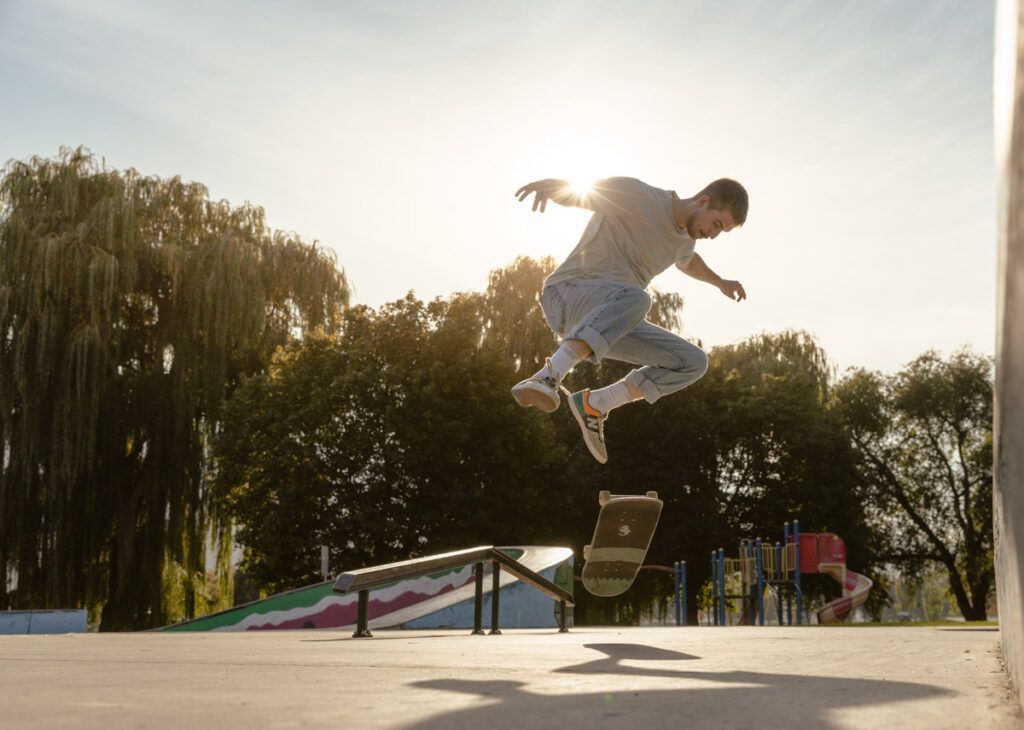When you’re looking to get a new set of wheels or are just getting into skateboarding, the options are overwhelming. Besides the graphics, colors, and physical size, it’s hard to really tell the difference between skateboard wheels. That is until you understand what to look for.
In this guide, you’ll learn exactly what types of skateboard wheels are out there, the specs that actually matter to your skating, along with some tips to help you choose the right wheel. To start, let’s talk about the four main “groups” of skateboard wheels.
The Different Types Of Skateboard Wheels
There are four main types of skateboard wheels: skatepark & street wheels, bowl wheels, cruiser wheels, and longboard wheels. The differences between these wheels are the size (diameter), hardness (durometer), and width to offer improved performance in certain areas.
– Skatepark & Street Wheels
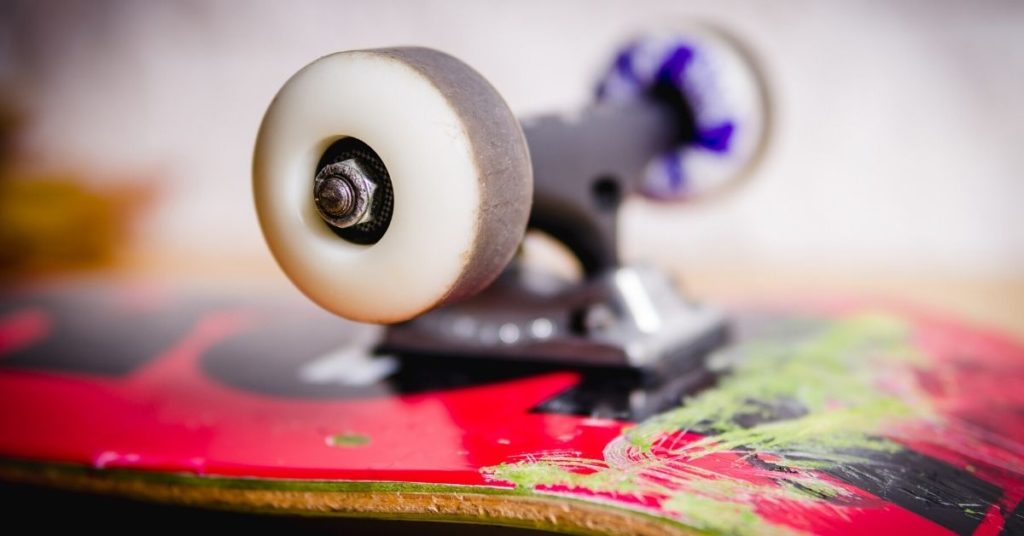
Skatepark and street wheels are meant to be versatile wheels that are easy to slide and pivot for tricks, roll fast, and strike a balance between grip and slidability. These wheels tend to be on the smaller end of the diameter range, typically between 51mm – 54mm. The smaller wheels are lighter than larger wheels, making them a better choice when popping tricks with a bit less effort.
Skatepark and street wheels are relatively hard as well, betwen 99a and 101a. With that said, some street-focused skaters will opt to use a 97a wheel to offset the rougher pavement found beyond the skatepark. These harder wheel durometers hold speed better than soft wheels and are fantastic for rolling around the skatepark.
Related: Best Wheels For Tricks & Street Skating
– Bowl & Transition Wheels
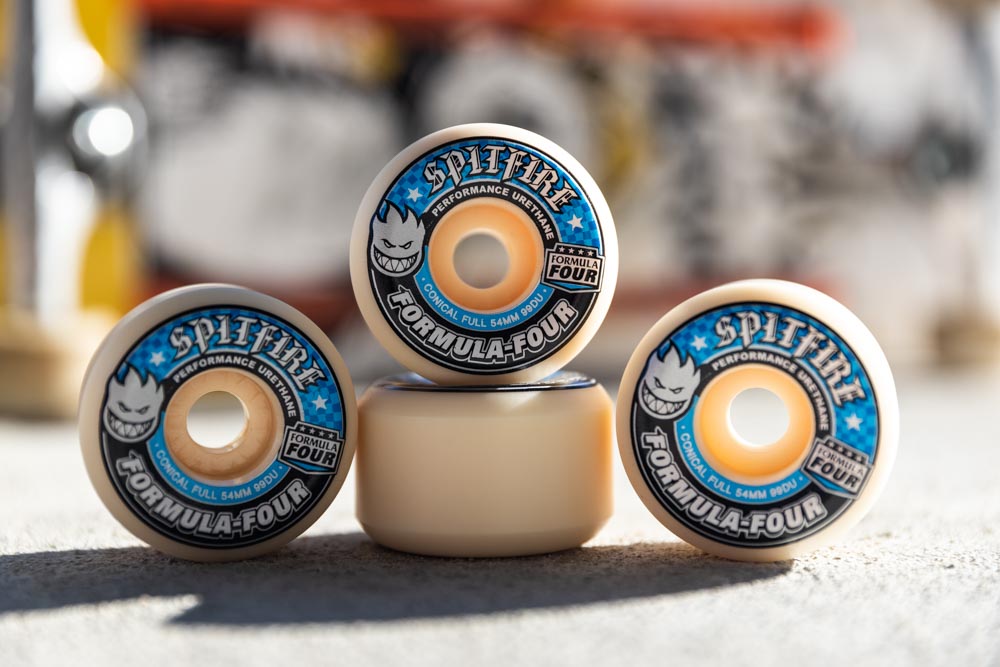
Bowl and transition skateboard wheels are meant for those primarily skating mini ramps, pools, bowls, and anything in between. These wheels have a wider contact patch and a larger diameter making them roll faster, feel more stable, and have a bit more grip too.
Compared to a street wheel, bowl wheels often have a 2mm – 5mm difference in the contact patch (the part of the wheel that actually rolls on the ground). This added width generates more friction between your wheel and the ground to create more grip. When you are leaning hard into a carve, this can add some extra security and stability that all ability levels can appreciate.
As for the diameter, bowl wheels are typically between 54mm – 58mm. The larger wheel sizes hold speed better to carry you between carves with less effort. These wheels also have a similar hardness to skatepark wheels with a 99a durometer as the go-to.
Related: Best Wheels For Bowls & Pools
– Cruiser Wheels
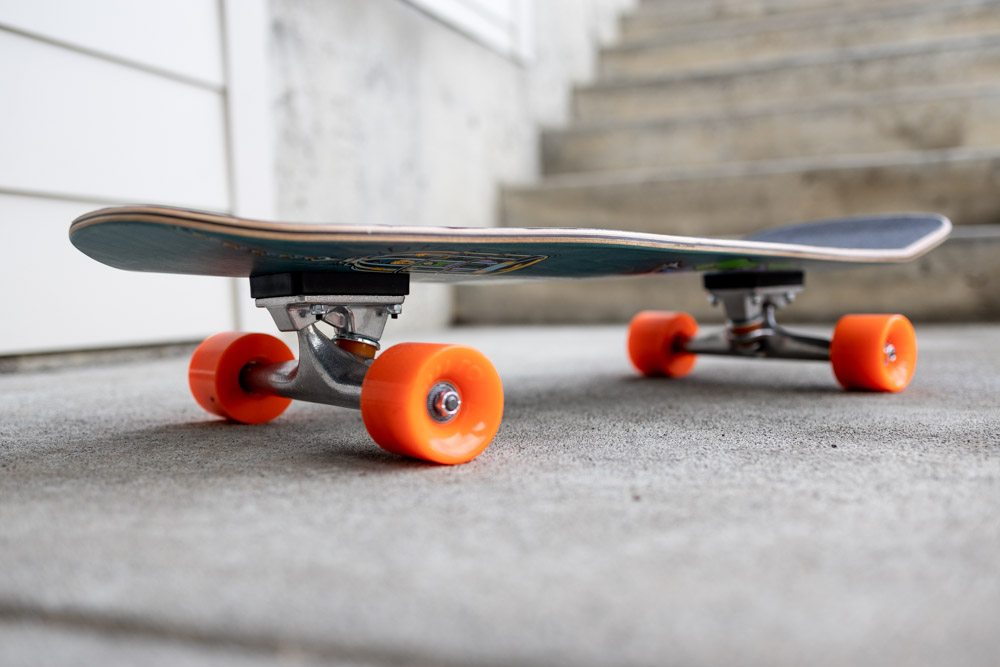
Cruiser wheels aren’t designed for doing tricks or cruising bowls (although you certainly still can). Instead, crusier wheels are meant to be large soft wheels that feel great to roll on rough roads with around town. An easy way to think of these is like a smaller diameter longboard wheel.
Cruiser wheels have a durometer in the range of 78a – 85a depending on your preferences. However, the more you plan to skate around town, the softer the wheel you should go with.
These wheels are also on the larger side, similar to the bowl and transition wheels. Generally, cruiser wheels range from 55mm – 60mm and will require a 1/8″ or 1/4″ riser pad to avoid wheel bite on a normal skateboard. Ultimately, cruiser wheels are meant to give you a comfortable ride no matter what type of pavement you roll over.
Related: Best Cruiser Wheels For Skateboarding
– Longboard Wheels
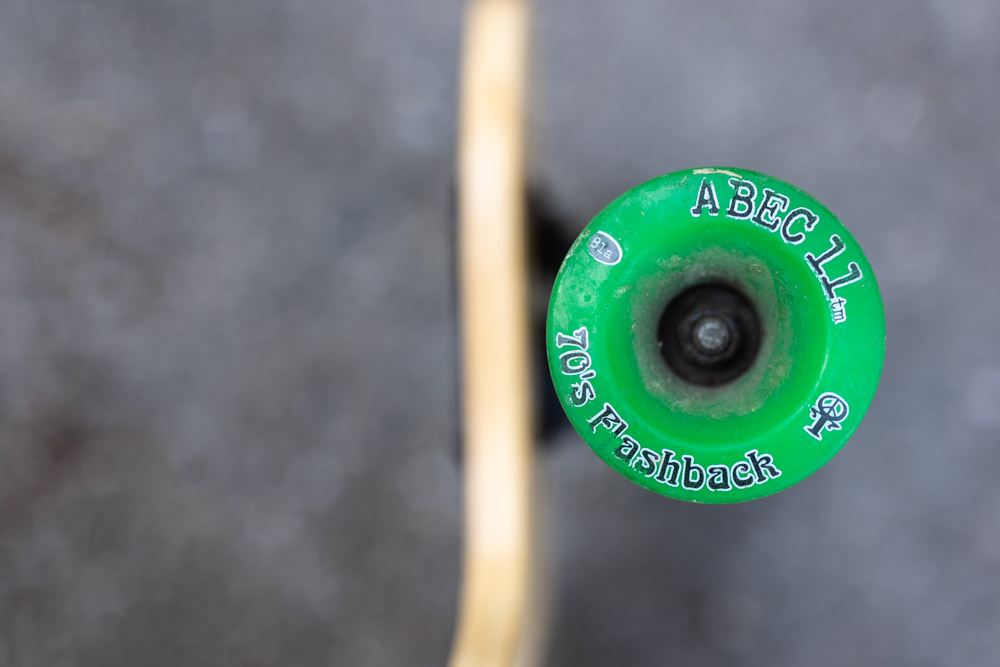
Longboard wheels are quite a bit different from regular skateboard wheels due to their size and durometer. Since longboards have a different board shape and trucks, larger wheels can fit within the wheel wells without causing wheel bite. This allows the wheels to be significantly larger, typically in the range of 68mm – 75mm wheels.
Longboard wheels are also relatively soft since longboards are usually riding on rough roads and need as much grip as possible. Longboard wheels commonly have a 75a – 80a wheel durometer making them the softest type of wheel you can find.
Unfortunately, these wheels are not meant to be put on a regular skateboard.
Can You Use Longboard Wheels On A Regular Skateboard?
If cruiser wheels aren’t cutting it, there are ways to get longboard wheels on a skateboard as long as they are 68mm or less in diameter. Anything larger will cause wheel bit even with a 1/2″ riser pad installed.
To make this work, all you need are some riser pads and 1 1/2″ hardware to add some space between your axle and the deck. From there, you can mount the wheels the same as you would a regular skateboard wheel.
I wrote a detailed guide with added tips for putting longboard wheels on a skateboard here if you want to give this a try.
Small Vs Large Wheels (Diameter)
In the last few sections you heard me talk about wheel size quite a bit, but how does that actually affect your skating?
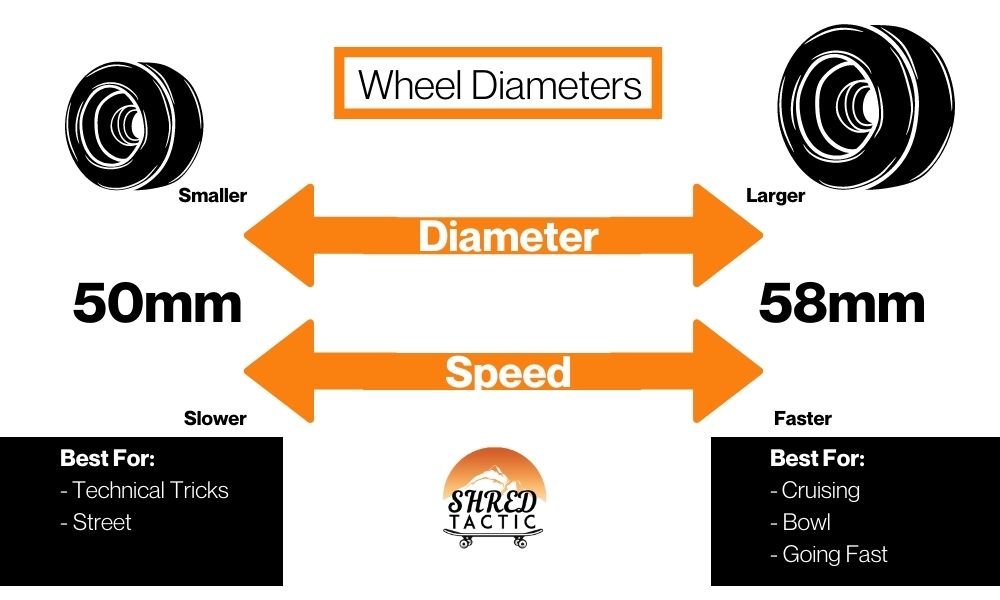
In simple terms, a smaller wheel accelerates faster, but has a slower top speed and won’t hold speed as long. A larger diameter wheel is the opposite, with a slower acceleration but holds speed better and will ultimately go faster too.
Smaller wheels also tend to have a shorter lifespan since there is less urethane to wear through compared to a larger wheel.
In a more sciency explanation, larger wheels extend further away from the axle to create more leverage as the wheel spins. With the added leverage, the wheel doesn’t have to work as hard to rotate the bearing around the axle and move you forward. A larger wheel also covers more physical ground per rotation, therefore making you roll faster than you would with a smaller wheel at a similar rate of spin.
Wheel diameter is measured in millimeters from one edge of the wheel to the other. Most skateboard wheels range between 50mm – 58mm but there are larger sizes available. The 50mm -58mmm range is just the most common for the broad scope of skaters.
You might be thinking that it’s a no-brainer to go with the larger wheels but there is one major downside to larger wheels which is weight. It might not seem like much but when you are trying tricks with a 51mm wheel compared to a 58mm wheel, you can tell. Smaller wheels are naturally lighter and give your board a more nimble feel.
Ultimately the most versatile wheel sizes are between 52mm – 54mm since you can skate just about anything. I like to skate bowl and street a lot, so I opt for the higher end of this range with 54mm wheels as my go-to.
Wide Vs Narrow Contact Path
When you go into any skateboard shop some wheels will look quite a bit thinner than others in terms of width. This width actually plays an important role in the performance of your wheel with either a narrow or wide contact patch.
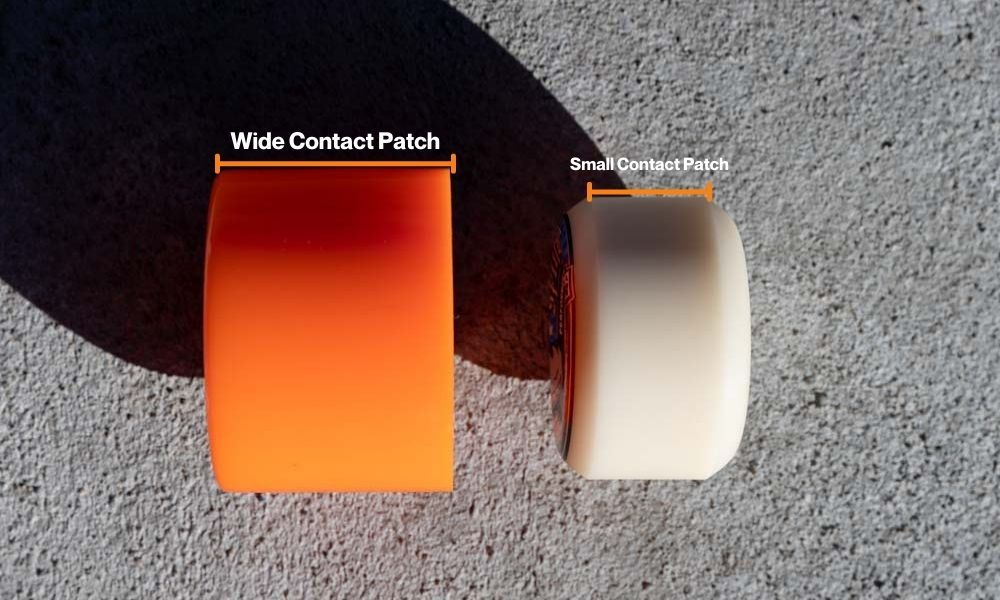
A more narrow contact patch is favorable for tricks and street skating since it’s much easier to slide your wheels. After all, there is literally less surface area of your wheel on the ground.
On the other hand, a wider contact patch feels more stable at high speeds making it ideal for bombing hills or riding bowls.
This choice ultimately comes down to personal preference and what you plan on skating. If you’re unsure, I would suggest going for a middle-of-the-road contact patch that’s not super thin or super wide. The Bones Classics V4 wheels and the Spitfire Formular Four Tablets are great examples of this.
Soft Vs Hard Skateboard Wheels Explained (Durometer)
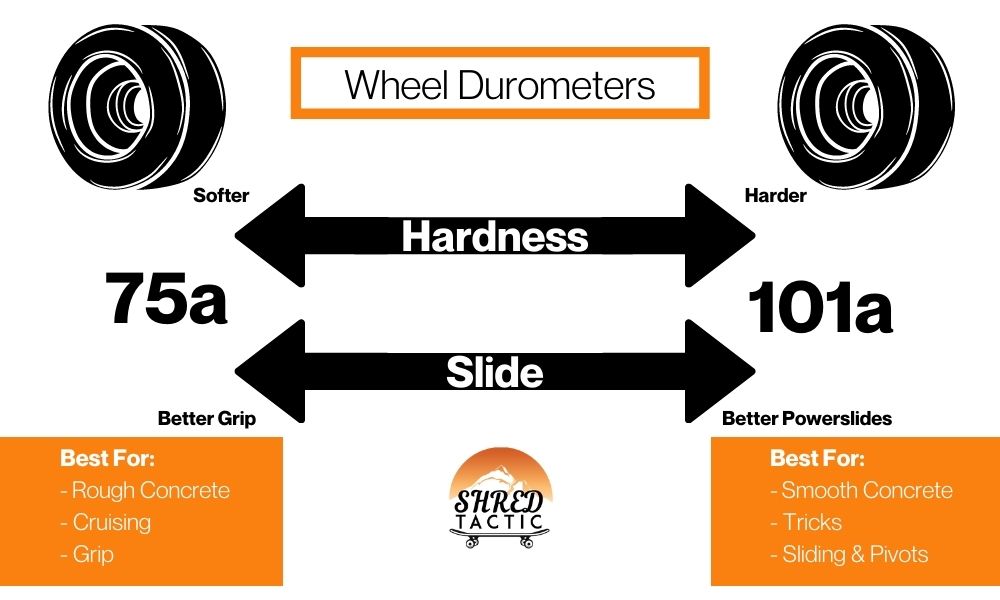
Skateboard wheel hardness is called the “durometer.” Softer skateboard wheels don’t hold speed as well as a harder wheel but offer superior vibration absorption and grip. An exaggerated way to think of soft wheels is like riding a bike with a flat tire. It’s harder to pick up speed, but the ride feels a bit more cushioned.
On the other hand, a harder wheel carries speed much better since it stays more rigid against the ground. The downside to this is that you will feel every little bump you roll over, making harder wheels unappealing to anyone looking to build a cruiser setup.
To make the choice easy, softer wheels should be used if you plan to ride around town or on rough pavement. Harder wheels should be used if you’ll spend most of your time at the skatepark or practicing flat ground tricks.
Understanding A-Scale & B-Scale Durometer Ratings
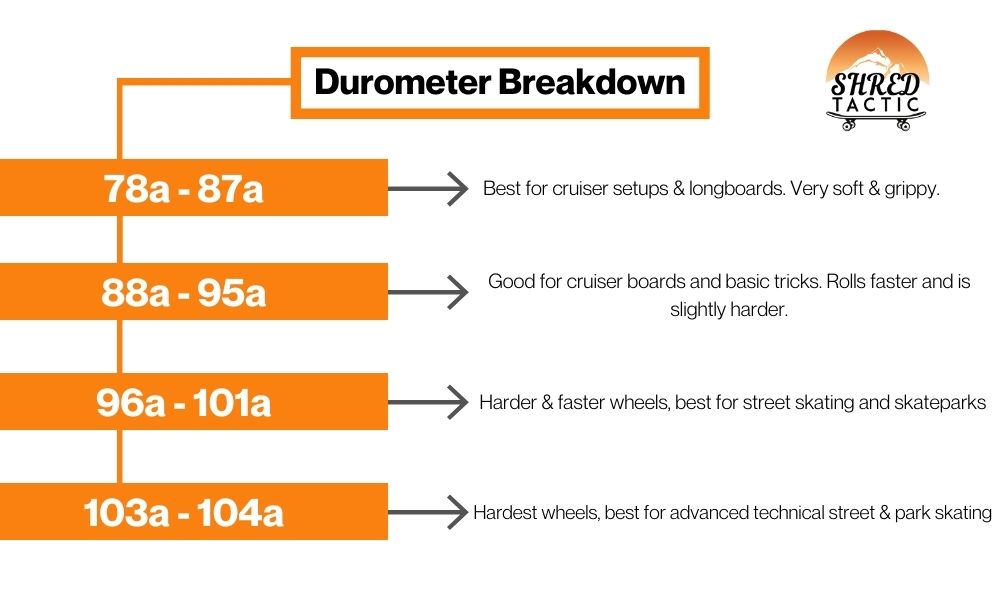
Durometer is typically measured on the A-scale which measures the hardness of a wheel on a scale from 0 – 100 with 100 being the hardest. For example, two common wheel durometers are 99A and 92A. A 92A wheel will be a slightly softer wheen than a 99A wheel. However, a 78A wheel would be much softer than a 99A wheel.
Some wheel manufacturers will opt to use the B-scale for their durometer ratings which is the equivalent of 20 points less than the A-scale. This means a 79B wheel is the same hardness as a 99A wheel.
The one exception to the A and B scale is with Spitfire. Spitfire rates their wheels as 99D for example, with D standing for Durometer. This rating system is still the same as the A-scale, meaning a 99D Spitfire wheel is really just 99A. It’s a bit confusing at first, but just try to think of it as the regular A-scale.
How To Choose A Skateboard Wheel
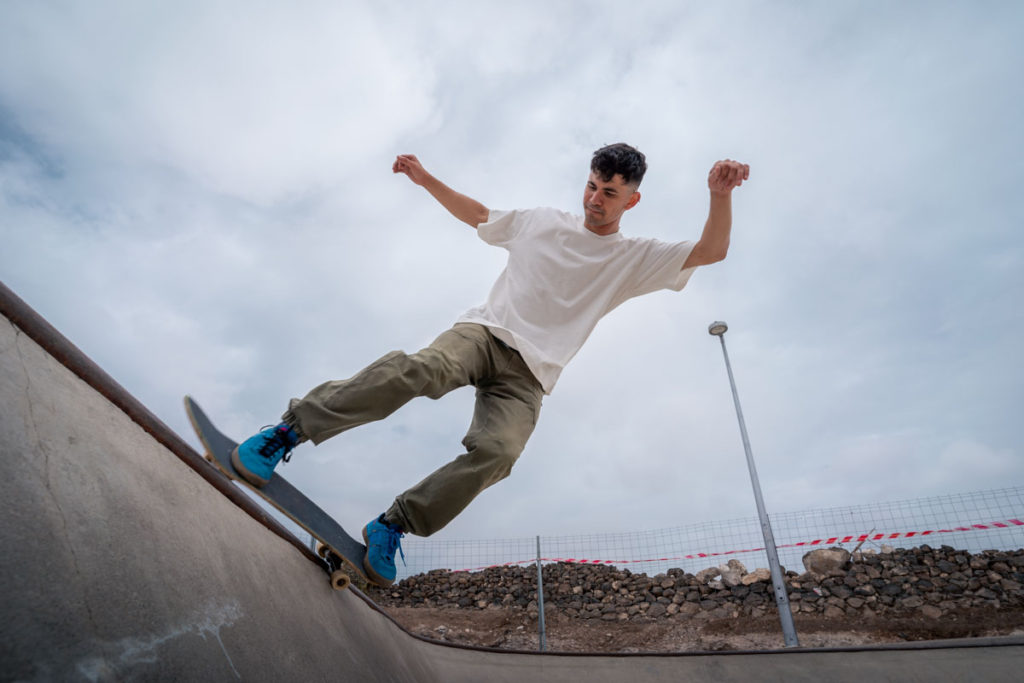
Now that you understand the types of skateboard wheels out there and the differences between them, let’s go through the thought process of choosing a wheel. Below are a few tips to help you choose a wheel based on your style of skateboarding and a some recommended wheels I’ve used and liked over the years.
| Wheel Type | Recommended Diameter | Recommended Durometer |
|---|---|---|
| For Skateparks | 52mm – 54mm | 99A – 101A |
| For Street | 52mm – 54mm | 97A – 99A |
| For Bowls | 54mm – 58mm | 97A – 99A |
| For Cruising | 56mm – 60mm | 78A – 85A |
| For Longboarding | 64mm – 80mm | 75A – 85A |
– Wheels For Skateparks
Wheel Specs To Look For:
- 99A – 101A
- 52mm – 54mm
- Narrow to medium contact patch
Wheel Recommendations:
- Spitfire Formula Four Classics (99A)
- Bones Classics Original Formula (101A)
- Bones STF Slims (99A)
At any skatepark, you’re going to find smooth concrete and you’re likely not there just to roll up and down the banks. In that case, you want a harder wheel that can hold speed well, slides nicely for flat ground tricks, and a size that’s suited to your style of skating.
As a general rule of thumb, go with a 99a – 101a wheel for skateparks with a 52mm – 54mm diameter. If you are more focused on flat ground tricks and tech skating, go for a harder wheel with a smaller diameter. For something that’s a bit more versatile if you want to skate a bit of bowl too, go with a 99a wheel with a 54mm diameter.
– Wheels For Street
Wheel Specs To Look For:
- 97A – 99A
- 52mm – 54mm
- Medium contact patch
Wheel Recommendations:
- Spitfire Formula Four Tablets (99A)
- Ricta Speedrings (99A)
- Spitfire Formula Four (97A)
Street skating requires a lot of the same things out of a wheel as the skatepark. The only difference is that you will spend more time on rougher roads too. Rather than going with a super soft wheel for a smoother ride, a harder wheel will feel more responsive for tricks on both flat and on features.
97A is a good durometer if you are looking for a slightly smoother ride without sacrificing the maneuverability of your board. 99A is a good all-around wheel durometer if you tend to go between street skating and skateparks.
– Wheels For Bowl & Transition
Wheel Specs To Look For:
- 97A – 99A
- 54mm – 58mm
- Medium to wide contact patch
Wheel Recommendations:
- OJ Elite Hardlines (99A)
- Powell Peralta G-Bones (97A)
- Spitfire Formula Four Conical (99A)
Having a larger wheel diameter for bowls will help to hold speed even if you aren’t the best at carving. 54mm – 56mm seems to be the sweet spot in my experience, but I know skaters who prefer the added speed a 58mm wheel offers. Just remember to get a 1/8″ or 1/4″ riser pad to avoid wheel bite if you go with a 58mm wheel.
Since bowls typically have a similar smoothness to the skatepark, a harder wheel will do the trick. With a wider contact patch, you can take advantage of improved grip despite a comparable wheel durometer to the skatepark wheels I mentioned earlier.
– Wheels For Cruising
Wheel Specs To Look For:
- 78A – 85A
- 56mm – 60mm
- Wide contact patch
Wheel Recommendations:
- OJ Hot Juice Wheels (78A)
- Santa Cruz Slime Balls (78A)
- Bones ATF Rough Riders (80A)
When it’s time to cruise it’s time to enjoy your ride. To make that possible on any type of cement, a large soft wheel will roll over anything with minimal vibrations. If you want the most comfortable ride possible, opt for a 78A wheel. However, if you want to powerslide and try a few cruiser board tricks, a slightly harder 80A – 85A wheel will be better suited.
Since cruiser wheels are quite a bit larger than normal skateboard wheels, make sure to get a 1/4″ or 1/2″ riser pad to ensure the wheels fit properly!
– Wheels For Longboards
Wheel Specs To Look For:
- 75A – 85A
- 64mm – 80mm
- Wide contact patch
Wheel Recommendations:
- Orangatang In Heat Wheels (80A)
- Cloud Ride Cruisers (78A)
- Orangatang Stimulus (80A)
Longboard wheels are a different beast than regular skateboard wheels. With completely different deck and truck shapes, longboards can fit much larger and wider wheels. These wheels can roll faster and have more stability at high speeds making them ideal for bombing hills and carving. However, if you want to do slides on your longboard, a harder wheel 80A and above will make that easier to do.
Just remember that none of these longboard wheels should be used with a regular skateboard deck as they won’t fit in most cases with few exceptions.
Choosing Skateboard Wheels FAQ
Can You Do Tricks With Soft Skateboard Wheels?
Yes, you can still do tricks with softer skateboard wheels but they won’t be as easy to slide and pivot. For some flat ground tricks and any rotational tricks on your skateboard, softer wheels are slightly harder to use. Generally, if you’re focused on learning tricks, you should use a harder skateboard wheel.
What Skateboard Wheels Should Beginners Choose?
If you’re a beginner skater you should get a wheel size and durometer that is versatile for any situation. A good starting point is a 54mm wheel with a 99A durometer. This type of wheel can be used for just about anything and is great to learn with.
Do Hard Wheels Slide Easier?
Yes, hard wheels slide easier since they are more rigid. That’s why anyone focused on tricks and technical skating prefers a harder wheel since you can slide and pivot with minimal effort.
Are 99A Wheels Considered Hard Or Soft?
99A wheels are considered hard. Just remember the A-scale used for durometer ratings that go from 0 – 100 points. The closer the rating is to 100, the harder the wheel will be. That means a 99A wheel is near the top of the hardness (durometer) scale.
